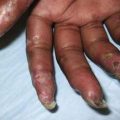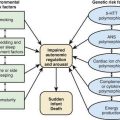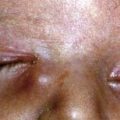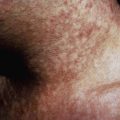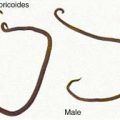Chapter 156 Sjögren Syndrome
Clinical Manifestations
International classification criteria have been developed for the diagnosis of Sjögren syndrome in adult patients (Table 156-1), and diagnostic criteria in children have been proposed. Clinical manifestations are related to exocrine disease of the epithelial surfaces of the eyes, mouth, nose, larynx and trachea, vagina, and skin, leading to the common symptoms of photophobia, burning and itching eyes, blurred vision, painless unilateral or bilateral enlargement of the parotid glands, decreased sense of taste, dental caries, dysphagia, fissured tongue, and angular cheilitis. At the onset of the disease, recurrent parotid gland enlargement and parotitis are the most common manifestation in children, whereas sicca manifestations are most common in adults. Subjective symptoms of xerostomia complaints are relatively rare in juvenile cases and are seen in < 45% of patients overall, perhaps indicating that Sjögren syndrome is a slowly progressive disease. Serologic markers (antinuclear antibodies [ANA], and antibodies to Ro [SSA] and SSB [La]) and articular manifestations are significantly more frequent in adults. Frequencies of the finding of ANA and SSA and SSB antibodies in children are reported to be 78%, 75%, and 65%, respectively. Rheumatoid factor is detected in two thirds of pediatric patients with Sjögren syndrome. Additional clinical manifestations from a variety of organ involvement patterns include a decreased sense of smell, epistaxis, hoarseness, chronic otitis media, and internal organ exocrine disease involving the lungs, hepatobiliary system, pancreas, gastrointestinal tract, kidneys, musculoskeletal, hematologic, and central nervous system (CNS).
Table 156-1 INTERNATIONAL CONSENSUS CRITERIA FOR SJÖGREN SYNDROME
OCULAR SYMPTOMS (AT LEAST 1 PRESENT)
Persistent, troublesome dry eyes every day for >3 mo
Recurrent sensation of sand or gravel in the eyes
Use of a tear substitute more than 3×/day
ORAL SYMPTOMS (AT LEAST 1 PRESENT)
Feeling of dry mouth every day for at least 3 mo
Recurrent feeling of swollen salivary glands as an adult
Need to drink liquids to aid in swallowing dry foods
OBJECTIVE EVIDENCE OF DRY EYES (AT LEAST 1 PRESENT)
Positive Schirmer I test result
Positive Rose-Bengal stain response
Lacrimal-gland biopsy sample with focus score >1
OBJECTIVE EVIDENCE OF SALIVARY GLAND INVOLVEMENT (AT LEAST 1 PRESENT)
Positive findings of salivary gland scintigraphy
Positive findings of parotid sialography
Unstimulated whole sialometry (≤1.5 mL/15 min)
LABORATORY ABNORMALITY (AT LEAST 1 PRESENT)
Anti-SSA or anti-SSB antibodies
Antinuclear antibodies (ANAs)
Immunoglobulin (Ig) M rheumatoid factor (anti-IgG Fc)
From Fox RI: Sjögren’s syndrome, Lancet 366:321–331, 2005.
Complications and Prognosis
The symptoms of Sjögren syndrome develop and progress slowly. Diminished salivary flow typically remains constant for years. Because monoclonal B-lymphocyte disease originates chiefly from lymphocytic foci within salivary glands or from parenchymal internal organs, there is increased risk for mucosa-associated lymphoid tissue (MALT) lymphoma. Maternal Sjögren syndrome can be an antecedent to the neonatal lupus syndrome (Chapter 152.1).
Bartunkova J, Sediva A, Vencovsky J, et al. Primary Sjögren syndrome in children and adolescents: Proposal for diagnostic criteria. Clin Exp Rheumatol. 1999;17:381-386.
Cimaz R, Casadei A, Rose C, et al. Primary Sjögren’s syndrome in paediatric age: a multicentre survey. Eur J Pediatr. 2003;162:661-665.
Civilibal M, Canpolat N, Yurt A, et al. A child with primary Sjögren syndrome and a review of the literature. Clin Pediatr. 2007;46:738-742.
Fox RI. Sjögren’s syndrome. Lancet. 2005;366:321-331.
Maeno N, Takei S, Imanaka H, et al. Anti-alpha-fodrin antibodies in Sjögren’s syndrome in children. J Rheumatol. 2001;28:860-864.
Manthrope R, Asmussen K, Oxholm P. Primary Sjögren’s syndrome: diagnostic criteria, clinical features, and disease activity. J Rheumatol. 1997;24(Suppl 50):8-11.
Ramos-Casals M, Tzioufas AG, Stone JH, et al. Treatment of primary Sjögren syndrome. JAMA. 2010;304(4):452-460.
Singer NG, Tomanova-Soltys I, Lowe R. Sjögren’s syndrome in childhood. Curr Rheumatol Rep. 2008;10:147-155.


